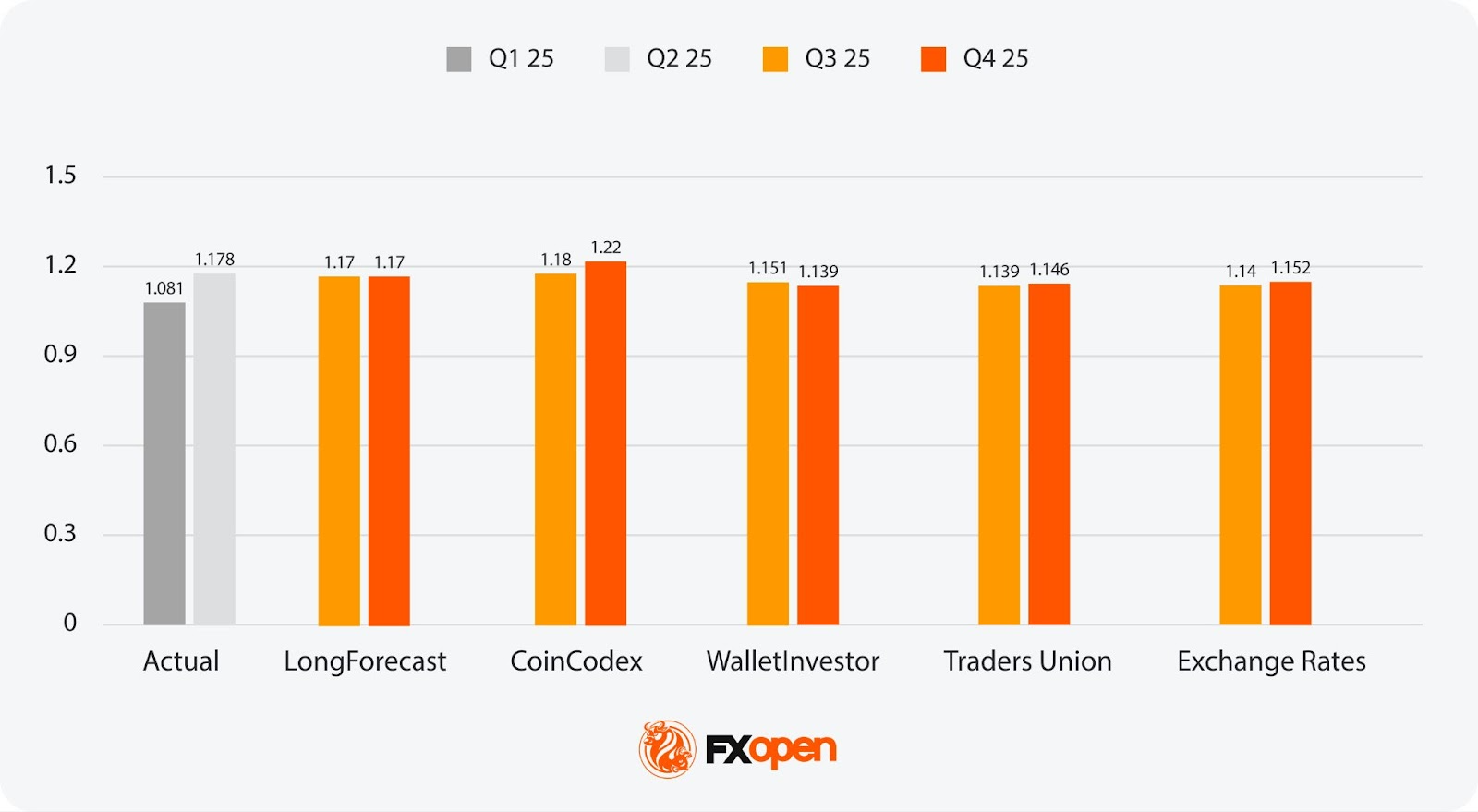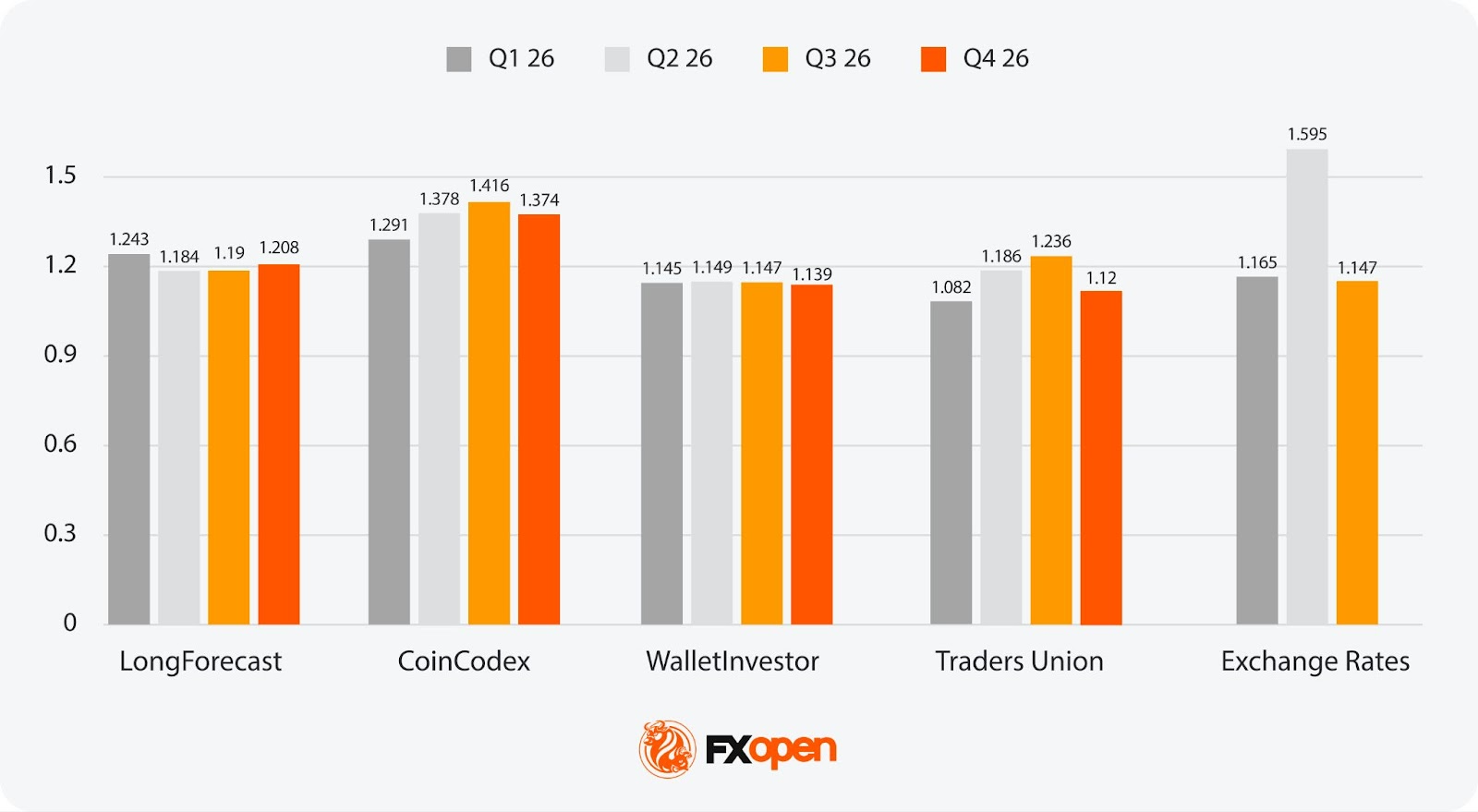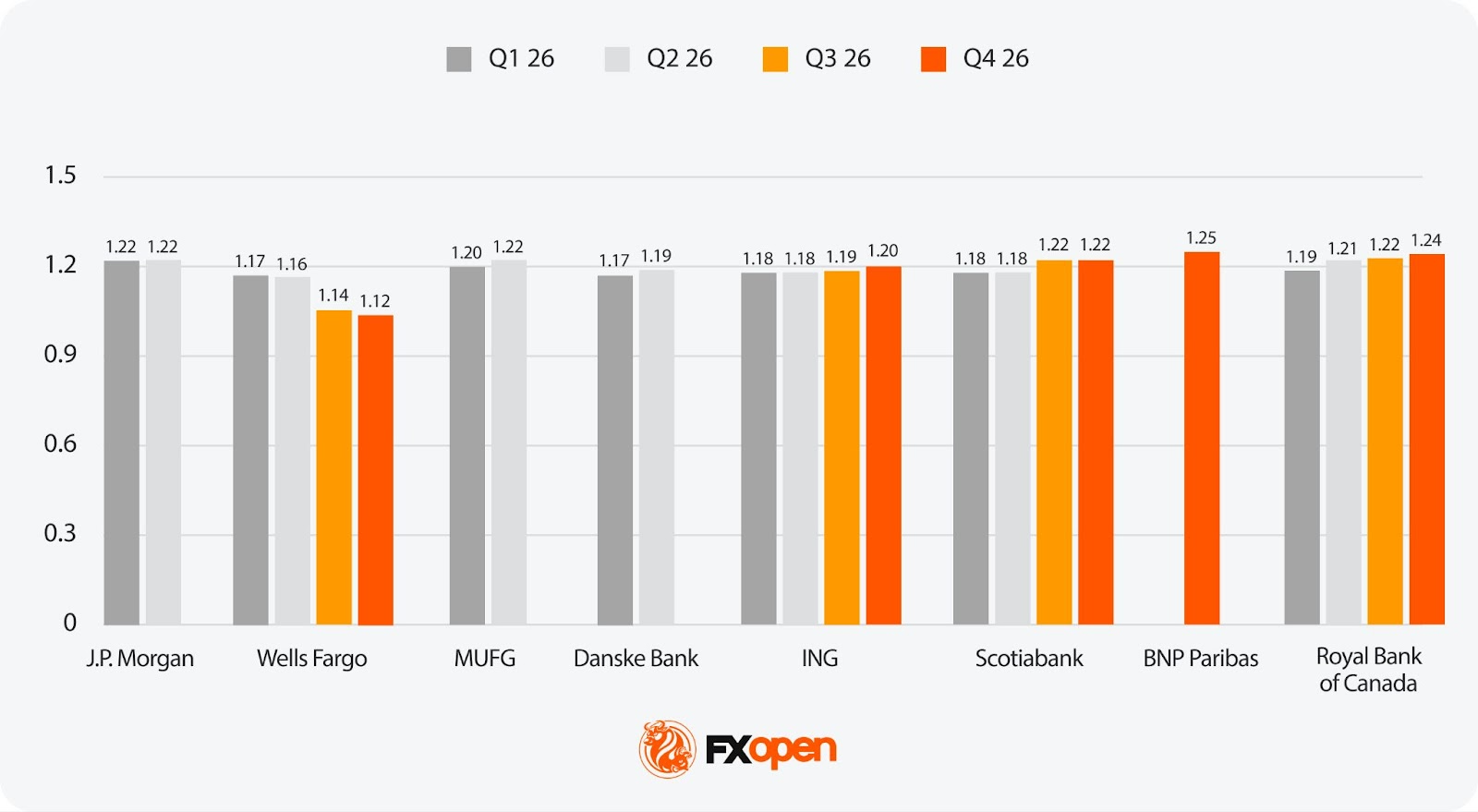FXOpen

EUR/USD has undergone a remarkable turnaround recently, rebounding from multi-year lows in early 2025 to levels above 1.17 in 2025 as shifting Fed policy expectations and a steadier Eurozone outlook reshape market sentiment. With analytical euro to dollar predictions pointing to moderate gains into 2026, here’s what to know about the key economic triggers that could define the next stage of the pair’s trajectory.
Historical Context and Recent Trends (2020–2025)
From 2019 to the present, the EUR/USD currency pair has navigated through turbulent economic waters, influenced by a series of global events and differing monetary policies between Europe and the United States.
Initially, the euro experienced a gradual depreciation against the dollar, moving from around 1.14 at 2019’s open to close the year at 1.12. This was largely due to the European Central Bank's (ECB) continuation of its quantitative easing program, coupled with its persistently low interest rate of 0%.
The onset of the COVID-19 pandemic in early 2020 sent the euro tumbling further to a low of approximately 1.06 as panic gripped global markets. However, recovery was swift, and by September 2020, the euro had climbed to a high of about 1.20, bolstered by the US dollar's comparative weakness.
The euro fluctuated between 1.23 and 1.17 in the first half of 2021. However, inflation began to rise in both the Eurozone and US economy, but more so in the US. The anticipation of steep hikes by the Federal Reserve caused it to close near 1.13 by year's end.
A significant milestone was reached in mid-2022 when the euro fell to parity with the dollar (1.00), driven by the ongoing conflict in Ukraine and acute inflationary pressures in the EU, exacerbated by energy shortages. Notably, the Fed also began raising interest rates in March 2022, with the pair reaching a low of 0.95 in September 2022.
The remainder of the year saw a recovery, with the euro to the dollar closing near 1.07, supported by the ECB’s decision to start increasing interest rates from July to combat inflation.
Throughout 2023, the pair largely ranged between 1.12 and 1.05, though predominantly on the bullish side. This year was mainly driven by anticipated Federal Reserve interest rate cuts and a sense of optimism, helping to drive the so-called safe-haven dollar lower and boost the euro.
From early 2024, EUR/USD began near 1.10, but gradually slid as the Federal Reserve maintained a hawkish stance amid strong US growth, while the ECB turned more dovish as Eurozone activity weakened. The pair trended down below 1.05 by late 2024, with the election of Donald Trump to the White House further bolstering the dollar. In January 2025, the euro briefly hit its low for the period at around 1.017, the weakest level since 2022, before starting a rebound.
Through mid‑2025, the euro surged. After the US’s announcement of sweeping global tariffs in April, the dollar plummeted, with the euro emerging as a so-called moderate safe-haven. Simultaneously, a stabilisation of Eurozone conditions and an increasing belief that a tariff-driven inflation spike would be short-lived pushed the pair to a high of 1.182, a level not seen since 2021.
By late July and into August, the rally moderated, with the exchange rate settling between 1.15 and 1.18 as markets assessed incoming data and awaited monetary policy signals from the Fed and ECB. As of mid-August 2025, EURUSD is priced at 1.17.
Macroeconomic Outlook for 2025–2026
The macroeconomic outlook for the Eurozone and US is expected to be shaped by slowing growth, shifting inflation trends, and the changing stance of the ECB and Federal Reserve. Understanding these dynamics may be important to assessing the forces that may drive EUR/USD over the next two years.
European Economic Outlook
According to analysts, the euro area economy is expected to experience modest growth over the next two years. The European Central Bank’s (ECB) June staff projections forecast real GDP growth averaging 0.9% in 2025 and 1.1% in 2026, building to 1.3% in 2027.
The OECD similarly anticipates a gradual recovery, with growth near 1% in 2025 and 1.2% in 2026, supported by resurgent foreign demand and improved real incomes. Consensus estimates from BusinessEurope and other institutions broadly align, pointing toward growth of around 1% in 2025, rising modestly in 2026.
Inflation pressures are easing. ECB staff expect headline inflation to average 2.0% in 2025, easing to 1.6% in 2026, with core (HICP excluding energy and food) retreating from 2.4% in 2025 to around 1.9% in 2026. The EU’s Spring forecast also projects inflation falling from 2.1% in 2025 to 1.7% in 2026.
In response to sluggish growth and subdued inflation, the ECB has continued easing. As of June, the deposit facility rate was cut to 2.0%—marking the seventh reduction in a year—and policymakers signalled that policy is approaching neutral, with further cuts possible if economic headwinds persist.
On the labour front, employment growth is slowing but unemployment remains low, forecast at approximately 6.1% by 2026. Fiscal pressures are easing, with a gradual return to more neutral budgets. However, elevated trade-policy risks—especially US tariffs—pose ongoing threats to investment and exports.
In summary, the euro area outlook is one of gradual recovery amid easing inflation, supported by accommodative monetary policy and resilient labour conditions—but still vulnerable to external trade shocks and weak investment dynamics.
US Economic Outlook
The US economy is anticipated to slow sharply in 2025, with Deloitte placing its real GDP growth forecast at 1.4, down from 2.8% in 2024. Growth is then expected to edge modestly higher to 1.5 in 2026, moving closer to near-trend performance in 2027.
Inflation is set to remain elevated in the near term, largely driven by tariff-related price pressures. Core PCE inflation is projected at ~3.1% in 2025, easing to ~2.4% by 2026, according to Fed projections. CPI forecasts from Fannie Mae also expect headline inflation near 3.2% in 2025, before easing next year.
The labour market is showing signs of softening but remains resilient. The unemployment rate is predicted by the Fed to average around 4.5% through both 2025 and 2026, with some projections indicating a slight rise toward 4.6% by the end of the period.
Risks to the outlook include persistent inflation pressures due to tariffs, labour force constraints from tighter immigration enforcement, and policy uncertainty. Moody’s chief economist Mark Zandi has warned the US may be on the verge of a recession, noting weak job creation (only 73,000 jobs added in July), declining labour force participation, and elevated inflation as warning signs.
Federal Reserve officials remain divided on the pace of policy easing. While some, like Fed official Michelle Bowman, support three rate cuts in 2025, others, like Atlanta Fed’s Raphael Bostic, remain cautious, emphasising the need for more clarity before easing monetary policy. The ascension of dove Kevin Warsh to the Fed’s board, replacing voting member and hawk Adriana Kugler, further complicates the monetary policy outlook.
In summary, 2025 might be a year of below-trend growth, sticky inflation, and a gradually softening labour market, with only modest improvement expected in 2026. The path of monetary policy and trade conditions will be important in shaping the outlook.
Analyst Euro to Dollar Forecasts and Consensus Outlook for 2025-2026
Recent euro to USD forecasts from major banks and institutions outline a moderate path of euro appreciation, supported by narrowing interest rate differentials and stabilising Eurozone fundamentals. These projections provide a framework for gauging potential EUR/USD ranges under varying economic and policy scenarios.
Euro to Dollar Forecasts for 2025
Euro to dollar forecasts in the next 6 months or so expect the pair to trade with a mild upward bias, supported by narrowing interest rate differentials as the Federal Reserve moves toward policy easing. With the ECB expected to hold rates steady after its recent cuts, the euro could take advantage of a period of relative policy stability while US rates trend lower. Key drivers will include incoming US inflation and labour market data, which could accelerate or slow the Fed’s path to cuts, as well as the durability of the Eurozone’s tentative growth recovery.
Risks to further gains include renewed geopolitical tensions, slower-than-expected Eurozone growth, or a reacceleration of US inflation that delays Fed easing. Conversely, a sharper US slowdown or stronger Eurozone data could push the euro towards the upper end of forecast ranges.
Algorithmic

Banks

Consensus Summary
Forecasts for Q3 and Q4 2025 largely cluster between 1.15 and 1.20. Algorithmic projections average around 1.15–1.17, while major banks lean slightly higher, with many targeting 1.18–1.20 by year-end.
The overall consensus places EUR/USD in the 1.17–1.19 range in Q4, reflecting expectations of moderate euro appreciation driven by policy convergence and stable risk sentiment, without a decisive break into the mid-1.20s.
If you would like to explore EUR/USD trends, you may consider opening a trading account on FXOpen’s TickTrader trading platform.
Euro to Dollar Forecasts for 2026
Looking ahead to 2026, EUR/USD forecasts suggest a continuation of the euro’s upward trajectory, albeit at a more measured pace. With the Federal Reserve expected to complete much of its easing cycle by early 2026 and the ECB maintaining relatively accommodative policy, interest rate differentials could remain narrow. This environment might provide the euro with a stable platform for gradual gains, especially if Eurozone growth improves from the sluggish pace of 2025 and inflation remains near target.
Key upside drivers might include a recovery in European exports if global trade tensions ease, stronger domestic demand across the euro area, and sustained capital inflows as investors diversify away from US assets. However, potential headwinds remain, particularly if US growth reaccelerates faster than expected, prompting the Fed to pause or reverse cuts, or if the Eurozone underperforms amid lingering structural challenges.
Algorithmic

Bank

Consensus Summary
Algorithmic models present a wide range, from the low 1.12s to above 1.37, while bank projections are more tightly grouped. Major banks generally forecast EUR/USD between 1.20 and 1.25 in Q4 2026, with the consensus clustering in the 1.22–1.24 range. This points to expectations of moderate euro appreciation, supported by balanced monetary policy settings and an improving European economic backdrop.
General Factors That May Influence the EUR to USD Rate
Several key factors may play pivotal roles in influencing the exchange rate between the euro and the US dollar. Understanding these may help traders and investors gauge potential currency movements:
- Economic Performance: The relative growth momentum of the US and Eurozone is a primary driver. Stronger US GDP growth, especially if accompanied by resilient consumer spending and business investment, is expected to strengthen the dollar. Conversely, if Eurozone growth outpaces expectations—through stronger exports, industrial output, or domestic demand—it might lift the euro. Recession risks on either side, such as a US downturn from restrictive policy or a Eurozone slowdown due to weak manufacturing, can tip the balance.
- Monetary Policy: The policy stance of the Federal Reserve and European Central Bank is closely monitored. Interest rate differentials are a critical determinant—higher relative US rates may support the dollar. Unexpected policy shifts, such as faster-than-anticipated Fed cuts in response to slowing inflation or an earlier-than-expected ECB tightening to contain price pressures, may trigger sharp moves in EUR/USD.
- Political Stability: Elections, fiscal policy changes, and governance issues in the US or Eurozone may cause volatility. For example, renewed tensions over EU fiscal rules or a contentious US debt ceiling debate may unsettle markets.
- Global Market Sentiment: The dollar often rises during periods of market stress due to its so-called safe-haven status. Events such as financial crises, geopolitical escalations (e.g. Middle East conflicts, Russia–Ukraine developments), or sharp equity sell-offs may spur dollar buying.
- Trade Balances: Changes in trade flows also matter. A widening US trade deficit is believed to weaken the dollar, while an improving Eurozone surplus—especially if energy import costs fall—may support the euro.
- External Shocks: Energy supply disruptions, sudden oil or gas price spikes, and global financial instability may influence central bank policy paths and investor sentiment, thereby impacting EUR/USD. Traders and investors monitor these developments continuously, as the interplay between them often determines the currency pair’s short- to medium-term direction.
Practical Applications of EUR/USD Forecasts
EUR/USD predictions for 2025–2026 provide more than just a projected rate—they outline the underlying assumptions that could drive the pair. By monitoring these specific factors, traders may see when the real economy starts to diverge from forecast scenarios.
Fed Policy Easing Timelines
Many euro to dollar forecasts for the next 6 months assume the Fed will begin cutting rates in September, with 2–3 moves before year-end. If US inflation—potentially kept higher by tariffs—remains sticky, this could delay cuts and support the dollar beyond forecasted levels. Watching monthly CPI/PCE prints and employment numbers will be critical to testing these assumptions.
ECB’s End of Easing Cycle
Forecasts expect the ECB is near to complete its rate-cut cycle. If Eurozone inflation (currently projected to average ~2.0% in 2025) undershoots due to weak energy prices or poor industrial output, the ECB could extend easing, undercutting euro strength expected in the 1.18–1.20 year-end range.
Trade and Tariff Shocks
Several projections account for lingering but non-escalating US-EU trade tensions. A sudden tariff hike—particularly on European autos—would pressure Eurozone growth forecasts (~0.9% for 2025), possibly knocking the euro away from the bullish bias. Traders can track US trade announcements and EU policy responses for early signals.
Growth Differentials
Consensus sees US growth slowing more than the Eurozone’s in 2026, helping EUR/USD push toward 1.22–1.24. If Q1–Q2 2026 US GDP data surprises to the upside, those gains could stall. Similarly, a Eurozone export rebound from falling LNG prices could accelerate euro strength beyond projections.
The Bottom Line
The EUR/USD pair has experienced a dramatic shift since early 2024, moving from multi-year lows near 1.02 to highs above 1.17 in mid-2025 as Fed policy expectations turned dovish and the euro found support from a stabilising Eurozone outlook.
Looking ahead, analytical euro to dollar exchange rate forecasts see the remainder of 2025 bringing more moderate euro gains, with most projections placing the pair between 1.17 and 1.19 by year-end, assuming Fed cuts begin later in the year and the ECB holds steady. Into 2026, projections tilt towards a gradual climb into the 1.22–1.24 range, contingent on sustained Eurozone recovery and a narrowing growth gap with the US.
While risks remain—from potential tariff escalations to shifts in inflation trends—analytical forecasts highlight key triggers to watch, including central bank timing, trade policy moves, and growth data surprises. Traders seeking to act on these evolving market dynamics, may consider opening an FXOpen account.
FAQs
Is the Euro Getting Stronger?
The euro has rebounded from early-2025 lows, supported by stabilising Eurozone growth and expectations of Fed rate cuts. However, US economic resilience, tariff-driven inflation risks, and potential ECB easing extensions could cap gains against the dollar in the near term.
What Is the EUR to USD Forecast for 2025?
Most analytical late-2025 euro to USD forecasts place the pair between 1.17 and 1.19, assuming Fed cuts begin in September and the ECB holds rates steady. Upside could be possible if US data softened faster or Eurozone growth surprised positively, but risks remain from policy and trade developments.
What Is the Future of EUR to USD?
Analytical EUR/USD predictions expect moderate euro appreciation into 2026, with consensus clustering around 1.22–1.24 by year-end. The outlook hinges on narrowing growth and interest rate differentials, while geopolitical risks, energy market shifts, and unexpected central bank moves could still disrupt the trend.
This article represents the opinion of the Companies operating under the FXOpen brand only. It is not to be construed as an offer, solicitation, or recommendation with respect to products and services provided by the Companies operating under the FXOpen brand, nor is it to be considered financial advice.
Stay ahead of the market!
Subscribe now to our mailing list and receive the latest market news and insights delivered directly to your inbox.








